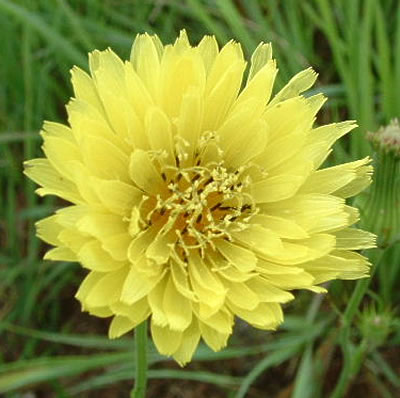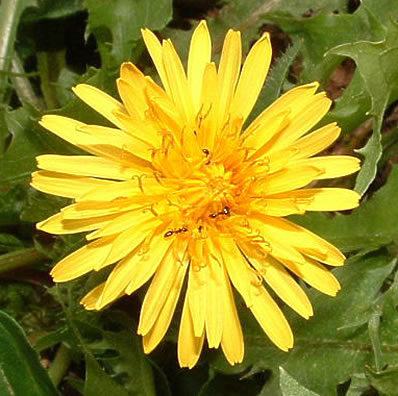Dandelions, True or False?
by Jan Haldeman*
Reprinted from the Winter 2012 Journal of the South Carolina Native Plant Society, and used by permission.
To see more pictures of these and other Dandelion look-alikes, click here.
If you ever notice commercials for herbicides, it seems to be “Roundup” time for dandelions just about all year long now. Especially if you are trying to maintain an ecologically unstable monoculture called a lawn. But dandelions have at least two look-a-likes in our area, which can be considered second cousins once, maybe twice, removed from the common dandelion (or what I like to call “true” dandelion), which is naturalized from Europe.
The two “imposters” which are so often seen in South Carolina along road shoulders, and in fields and lawns during the warm season are Cat’s Ear, Hypochaeris radicata, also naturalized from Europe, and our native Carolina False Dandelion, Pyrrhopappus carolinianus.

Cat’s ear
(Hypochaeris radicata)

Carolina false dandelion
(Pyrrhopappus carolinianus)

“True“ dandelion
(Taraxacum officinale)

| Hairy Cat's Ear | Carolina False Dandelion | “True” Dandelion | |
|---|---|---|---|
| Flowering Stalk | Branched Solid No stem leaves |
Branched Solid Some stem leaves |
Not branched Hollow No stem leaves |
| Leaves | Lobed Hairy |
Sharp-toothed Smooth, not hairy |
Sharp-toothed Smooth, not hairy |
| Growth Cycle | Perennial | Annual/Biennial | Perennial |
These two and “true” dandelion have similar yellow blossoms composed of many tiny individual flower units which appear as one flower, a distinguishing feature of the family Asteraceae. Blossoms are a composite of many individual flowers and therefore, Compositae is another name for this family.
Some family members, like sunflowers and daisies, have two forms of flower units, disc flowers forming a blossom’s center, and ray flowers circling the periphery and forming what appear to be petals. The one true dandelion and the two “imposters” have blossoms of ray flowers only.
So how can you tell which is which? Since the blossoms look a lot alike, you need to pay attention to other parts, in particular the leaves and flowering stem. Even though all three have similarly shaped coarsely toothed leaves forming rosettes at the plant’s base, ONLY Cat’s Ear has leaves covered with stiff hairs. These fuzzy leaves are responsible for its common name, and it has other common names including Hairy Dandelion.
Then, Cat's Ear and Carolina False Dandelion have branching green stems with SEVERAL blossoms. True dandelions produce ONLY ONE blossom per flowering stem. Carolina False Dandelion has a leafy stem, and is also called Leafy Stem Dandelion.
In addition, blooms of Cat’s Ear and True Dandelion are a chrome yellow, while those of Carolina False Dandelion often may look more like a “lemon” yellow. Carolina False Dandelion is also called Carolina Desert Chicory, although its range doesn’t extend as far west as the desert states. All three plants make spherical clusters of “parachuted” fruits that scatter about on the wind.
The scientific name for “True” Dandelion, Taraxacum officinale, comes from Greek words, taraxos = disorder, akos = remedy, and officinale = official. Therefore, the Dandelion, disdained star of herbicide commercials, is actually a long-time proven “official” remedy for kidney, digestive and liver disorders.
The common name is corrupted from French Dent = tooth (teeth), de = of, and Leon = lion, thus in French, dandelion is dent de leon, or “teeth of the lion,” referring to its coarsely sharp-toothed leaves. And in German, dandelion is loewenzahn which also translates as “lion’s tooth.”
All parts of True Dandelions are edible and healthful. Fresh greens (bitter-tasting like endive) and blossoms can be used in fresh salads, and greens can be served as a pot herb. Raw greens contain as much calcium and Vitamins A, C, thiamine, and riboflavin as most multi-vitamins. Roots can be roasted and used as a coffee substitute. To make dandelion “coffee,” gather, wash, dry and then roast the roots for four hours or until dark brown and cracking. Then grind them, and prepare as you would coffee beans. Flowers and whole plants are used to brew wine and beer.
It is no wonder that early on, arriving colonists from Europe included in their luggage highly valued seeds of an important food and medicinal plant such as Dandelion. They, as well as other valued plants from native lands, were grown in colonial gardens, from which they and many other species, intentionally or accidentally, spread throughout our country. Cat’s Ear and Carolina False Dandelion are also edible, and folks who have tried them say that they are not as bitter as Common Dandelion. Some medicinal properties similar to True Dandelions have been reported for Cat’s Ear, and even a few for Carolina False Dandelion.
With respect to Cat’s Ear, as it turns out, South Carolina is home to two additional quite similar species, Smooth Cat’s Ear, Hypochaeris glabra, an annual with leaves that are less hairy, and Brazilian Cat’s Ear, Hypochaeris chillensis, whose flowering stalks do have some leaves near its base. But with close inspection, these, like Hairy Cat’s Ear, can be distinguished from Carolina False and “True” Dandelions.
And since the Aster family is so large, it includes even more dandelion look-a-likes. To name only a few, there are Hawkweeds in the genus Hieracium, Hawk’s Beards in the genus Crepis, and Dwarf Dandelions in the genus Krigia, each of which includes several similar yellow-flowered species with stories to tell as well.
Article photos by the author.
* Dr. Haldeman is Professor Emeritus of Biology, Erskine College, and former Chair of the South Carolina Native Plant Society's Exotic Species Committee.

